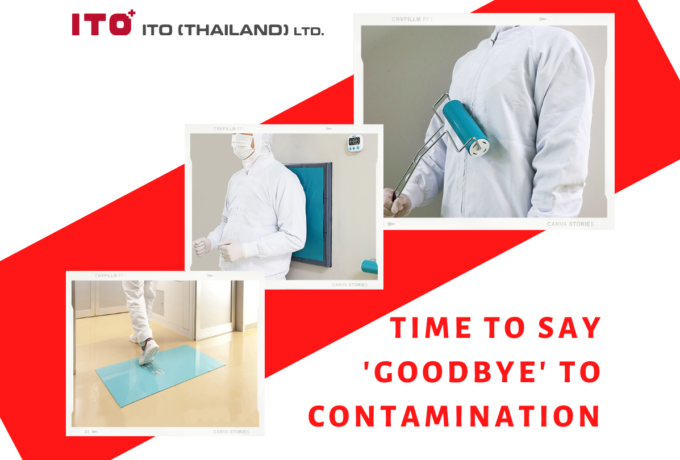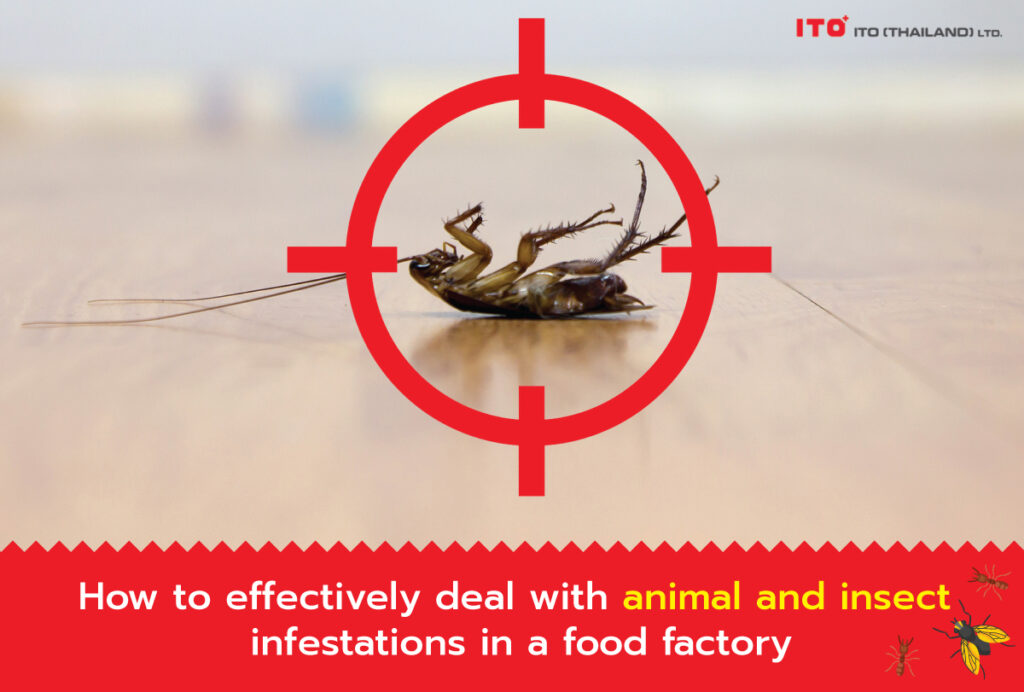ITO Thailand Hygiene Blog
Pest Control in Food Industry
4 Groups of Pests Found in Food Factory(1,2)
Flying insects such as flies, whiteflies, mayflies, flying ants, etc.
May be contaminated with microorganisms that spoil food or pathogen carriers, such as dysentery, typhoid, cholera, hookworm and earthworm, that hang onto their bodies and legs; their droppings in food or their eggs laid in food including contamination of their parts (e.g. wings, legs) in the products.
Crawling insects such as cockroaches, ants, moths including arachnids; for example, spiders
The most common groups found are cockroaches and ants with possibility of their parts, eggs or droppings contaminated in food by gnawing and destroying raw materials, emitting unpleasant odors and being contaminated with pathogens or microorganisms that spoil food. In case of spiders, they may produce webs and cobwebs that can trap dust and other insects contaminated in food.
Poultry; for instance, birds
Bird droppings are acidic that can corrode surfaces or risk the danger of slipping, as well as, may be contaminated with pathogens, parasites, fungi, especially St. Louis encephalitis and salmonella in poultry which previously the outbreak of salmonella disease had ever been reported that it was caused by birds excreted on food raw materials (3). In addition, physical contaminants, such as bird carcasses, feathers, parts of bird’s nests, may fall into the products and the microbial contamination that spoils food and attracts other pests such as flies, cockroaches including making disturbing noise too.
Mammals such as dogs, cats, rats, etc.
Dogs and cats may be attracted into the area by food scraps and excrete their dungs becoming the reservoirs of hair contamination in food, the carriers of insects (such as ticks and fleas), and microorganisms into the food, as well as, the carriers of diseases to employees such as rabies, toxoplasmosis, allergies, etc.
Rats are the main pests found due to being small animals and able to swim, climb or easily go through small holes. Rats can breed quickly, gnaw and destroy raw materials and almost all types of equipment including electrical wires. Also, they are carriers of many types of pathogens and reservoirs of contamination starting from hair, droppings, insects to animal carcasses.
3 Pest Prevention Techniques
Reducing Attraction to External Animals
-Hygienic management of potential food sources for animals such as keeping the raw materials in closed containers, appropriate waste management by tightly tying and putting away from production areas including food scraps from the staff’s leftovers, sewer management and toilet cleaning
-If the production process consists of a process producing the smell that attracts animals such as the fermentation process where the smell attracts whiteflies or flies, a proper deodorization management is required by installing the insect filters and having a schedule for regularly cleaning the odor vent.
-Management of environment that attracts pests such as putting flowers that attract insects and trees or building awnings that attract birds to build nests away from production buildings or installing equipment such as bird net and insect net
-Paying attention to clean the production line to reduce the chance of attracting pests with food stains
-Some kinds of insects may be attracted to light at night. Therefore, installation of lamps or using light must be carefully considered. Sodium vapor lamps may be installed instead of mercury vapor lamps in order to make the light comes out light yellow instead of bright white to reduce the attraction of insects or the light poles should be installed separately from the building (2), etc.
Risk Mitigation at the Entrance and Exit
-Checking the entrances and exits that may be used by animals such as sewers, leaks, cracks, windows and have them repaired appropriately such as installing insect traps for sewers, mosquito nets or nets to cover the edge of the doors that may be gnawed by rats and periodic maintenance of the building
-In the area that is the entrance and exit of employees, the space and opening time should be minimized as much as possible to reduce the risk of pests entering and exiting from outside, especially the insect groups, such as installing strip curtains and automatically closing doors, using air curtains and high-speed opening and closing
-Using the principle of colors to repel or attract insects; for instance, Magic optron canvas technology in Japan is patented for using colors in light waves that insects cannot see at outside to reduce the attraction of insects and using the colors that attract the insects at inside to attract insects that may remain to stay at the door. According to the experiment, such prevention of insects was found 80.7% effective without using chemicals.
-Changing shoes and the use of shoe sole cleaning equipment, such as sticky pads for pedals or boot washer including cleaning the wheels of transport trucks or forklift trucks that have to go in and out the production area to reduce the risks of treading on insects, insect remains, animal droppings, dirt into the production area and stepping on food stains such as blood stains, grease stains, as well as, walking to spread the stains around the production area which may attract pests
Handling Animals that May Slip into Production Area
-Raw materials that are mixed with animals may require special handling such as chemical fumigation to kill moths and use of microwaves(4)
-Checking the traces such as burrows, animal droppings, gnawing bites, hair or carcasses regularly
-Installation of traps such as insect light traps, mouse traps, baits and glue traps. However, the use of these traps or baits must take into account the risks of chemical contamination in food or management of animal carcasses not to be mixed into the food as well.
References
1.การควบคุมสัตว์พาหะนำโรค. [online] http://www.facagri.cmru.ac.th/2013/wp-content/uploads/2013/03/%E0%B8%9A%E0%B8%97%E0%B8%97%E0%B8%B5%E0%B9%885-%E0%B8%AA%E0%B8%B1%E0%B8%95%E0%B8%A7%E0%B9%8C%E0%B8%9E%E0%B8%B2%E0%B8%AB%E0%B8%B0.pdf
2.Australian Environmental Pest Managers Association and the Pest Management Association of New Zealand. 2014. A Code of Practice for Pest Management in the Food Industry in Australia & New Zealand (2nd edition)
3.https://foodpoisoningbulletin.com/2012/salmonella-outbreak-bird-poop-on-peanuts-at-sunland-plant/
4.พูนพัฒน์ พูนน้อย, เบญญทิพย์ มหาเทพ, ภิญญาพัชญ์ พุฒตาล. การทำลายไข่มอดในข้าวอินทรีย์ด้วยคลื่นไมโครเวฟ. วารสารวิจัยและพัฒนา มจธ. ปีที่ 33, ฉบับที่ 1 (ม.ค.-มี.ค. 2553), หน้า 39-48
Related Post
-

Liquid nitrogen in food industry
You maybe have heard that liquid nitrogen can rapidly freeze the food, haven’t you? And what are its advantages and benefits? Let's get to know the liquid nitrogen in food industry with ITO (Thailand).
-

Ultrafine bubble (UFB) technology (Part 2)
The previous content has discussed the benefits of the ultrafine bubble technology in agriculture, livestock, and fisheries, cleaning raw materials and various surfaces. Today, we will continue to learn about the use of the ultrafine bubble technology in food production processes and waste management from the food industry and how to create these tiny gas bubbles.
-

Ultrafine bubble (UFB) technology (Part 1)
Simple bubbles when transformed into the micro-nano level can do more than you think. Let's learn about the technology of these tiny bubbles and their application in the food industry with ITO (Thailand).
-

Frozen food storage management
Freezing is a method of food preservation commonly used in food that goes bad quickly such as ready-to-cook fresh food, ready meals, or foods in which nutritional values decay easily, or have substances that are sensitive to temperature, light, oxygen, etc. Freezing uses a principle of quickly solidifying water in the products, making the molecules of the substances unable to react to one another, thus the foods last longer. It also suppresses the growth of microorganisms and kills parasites. For instance, USFDA suggested controlling parasites in fish consumed raw such as sushi and sashimi by freezing the fish at the minimum of 20 degrees Celsius for 7 days or stored at -35 degrees Celsius for 15 hours to control parasites in fish (conditions may depend on the size of the fish as well).
-

Boot Cleaner
Pay attention to the hygiene of the footwear for good hygiene in the food industry
-

Innovation for sustainable physical contamination prevention
It is known that external impurities pose a food safety risk. One of the main channels of contamination is the presence of humans as a carrier of dust and dirt into the production or high-risk areas, causing dirt, germs, or foreign matters to contaminate food and harm consumers.










